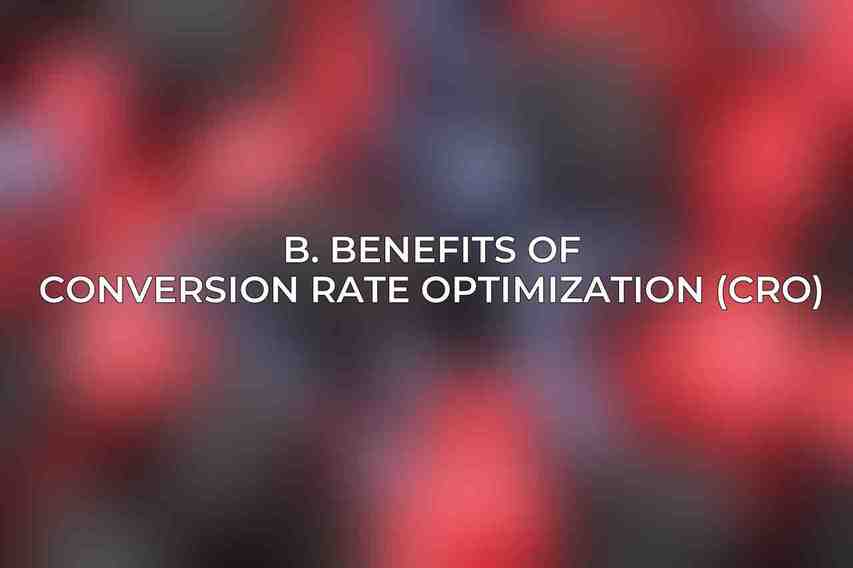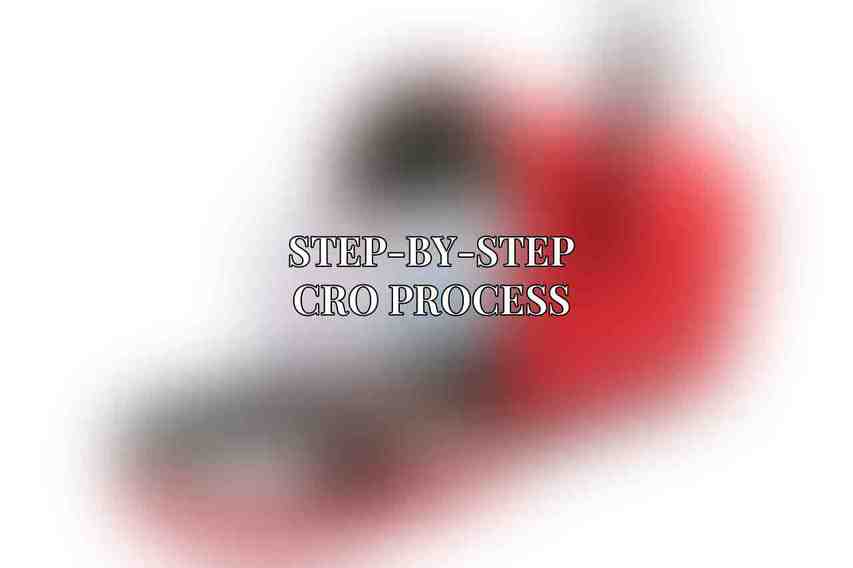Conversion Optimization has become a critical aspect for businesses looking to enhance their online presence. Conversion Optimization focuses on improving the performance of a website by increasing the percentage of visitors who take the desired action, such as making a purchase or filling out a form.
A. Definition and Importance
Conversion Optimization, also known as Conversion Rate Optimization (CRO), is the systematic process of increasing the percentage of website visitors who take the desired action. This could include making a purchase, signing up for a newsletter, or filling out a form.
B. Benefits of Conversion Rate Optimization (CRO)

The primary benefits of CRO include increased revenue, improved return on investment (ROI), better user experience, and a deeper understanding of customer behavior. By optimizing the conversion process, businesses can make the most out of their existing traffic and maximize their online potential.
C. Setting Goals for CRO
Setting clear goals is essential for a successful CRO strategy. Whether the objective is to increase sales, boost sign-ups, or enhance user engagement, defining specific and measurable goals will guide decision-making and help track progress effectively.
Key Concepts in Conversion Optimization
Successful Conversion Optimization relies on understanding key concepts and implementing strategies that target various elements of a website.
A. Conversion Funnel
The Conversion Funnel represents the journey a user takes from entering a website to completing the desired action. Understanding each stage of the funnel allows businesses to pinpoint areas for improvement and optimize the flow for increased conversions.
B. Landing Page Design
Landing Page Design plays a crucial role in conversion optimization. A well-designed landing page should be visually appealing, easy to navigate, and focused on guiding visitors towards the desired conversion action.
C. Call to Action (CTA)
A compelling Call to Action (CTA) prompts visitors to take a specific action, such as “Buy Now” or “Sign Up.” The placement, design, and wording of CTAs can significantly impact conversion rates.
D. Forms and Data Capture
Forms are often used to collect information from visitors. Optimizing form fields, reducing friction in the submission process, and ensuring data privacy can all contribute to improved conversions.
E. A/B Testing
A/B Testing involves comparing two versions of a web page to determine which one performs better in terms of conversions. This iterative testing process helps identify the most effective design and content variations.
CRO Strategies for Different Elements
To optimize conversions effectively, businesses must focus on various elements of their website.
A. Optimizing Headlines
Engaging and optimized headlines can grab the visitor’s attention and communicate the value proposition clearly. A/B testing different headline variations can help identify the most effective wording.
B. Enhancing Content Clarity
Clear and concise content is essential for conveying information effectively and guiding visitors towards conversion actions. Utilizing bullet points, visuals, and strategic placement of key information can enhance clarity.
C. Removing Distractions
Eliminating unnecessary distractions on a webpage can help keep visitors focused on the primary conversion goal. Simplifying design elements and streamlining the user experience can reduce friction and improve conversions.
D. Using Social Proof
Social proof, such as customer testimonials, reviews, and trust badges, can build credibility and trust with visitors. Incorporating social proof strategically throughout the website can influence purchase decisions positively.
E. Improving Website Speed
Website speed is a critical factor in conversion optimization. Slow-loading pages can lead to high bounce rates and lost conversions. Optimizing images, content delivery, and server response times can improve site speed and enhance user experience.
Step-by-Step CRO Process

Implementing a structured CRO process is essential for achieving sustainable improvements in conversion rates.
A. Analytics and Data Analysis
Utilizing analytics tools to track visitor behavior, identify key metrics, and gather valuable insights is the first step in the CRO process. Data analysis provides a foundation for making informed decisions.
B. Identifying Conversion Barriers
Pinpointing conversion barriers, such as usability issues, unclear messaging, or technical glitches, allows businesses to address specific challenges that hinder conversions.
C. Developing Hypotheses and Testing
Formulating hypotheses based on data insights and industry best practices sets the stage for effective testing. A structured approach to testing variations helps validate hypotheses and optimize conversion elements.
D. Measuring and Analyzing Results
Measuring the impact of changes on conversion rates and analyzing the results is crucial for evaluating the effectiveness of CRO strategies. Data-driven decision-making enables continuous refinement and improvement.
E. Iteration and Continuous Improvement
The CRO process is iterative and requires ongoing monitoring, testing, and refinement. By continuously optimizing conversion elements and experimenting with new techniques, businesses can achieve sustained growth in conversions.
Advanced CRO Techniques
Advanced Conversion Optimization techniques allow businesses to elevate their strategies and drive even higher levels of performance.
A. Heatmaps and Session Recordings
Heatmaps and session recordings provide visual insights into user behavior, interactions, and engagement on a website. Analyzing heatmaps and recordings can reveal valuable information for optimizing conversion paths.
B. Personalization and Segmentation
Personalization tailors the user experience based on individual preferences and behavior, increasing relevance and engagement. Segmentation allows businesses to target specific audience segments with customized content and offers.
C. Email Marketing Automation
Email marketing automation enables personalized, timely communication with leads and customers. Automating email campaigns based on user actions and behaviors can drive conversions and nurture relationships.
D. Customer Journey Mapping
Understanding the customer journey from awareness to conversion helps businesses create a seamless and personalized experience. Mapping out touchpoints and optimizing interactions at each stage can improve overall conversion rates.
E. CRO Tools and Software
Leveraging a variety of CRO tools and software, such as Google Analytics, Crazy Egg, Optimizely, and Hotjar, provides valuable resources for analyzing data, testing variations, and optimizing conversion elements. Exploring and utilizing the right tools can streamline the CRO process.
Case Studies and Examples of Successful CRO Campaigns
Examining real-world case studies showcasing successful CRO campaigns can provide valuable insights and inspiration for businesses looking to enhance their own strategies.
A. Company X: Increased conversion rate by 15%
By implementing targeted CRO strategies, Company X was able to achieve a significant 15% increase in their conversion rate, leading to improved performance and increased revenue.
B. Company Y: Generated $1 million in additional revenue
Through a comprehensive CRO campaign, Company Y generated an impressive $1 million in additional revenue by optimizing key conversion elements and improving user engagement.
C. Company Z: Improved user experience and reduced bounce rate
Company Z focused on enhancing user experience and reducing bounce rate through CRO initiatives. The result was a more engaging website that retained visitors and increased conversions.
Best Practices for CRO
Embracing best practices in Conversion Optimization is essential for driving sustainable growth and maximizing performance.
A. Data-Driven Approach
Making decisions based on data and analytics ensures that CRO strategies are grounded in insights and facts, leading to more effective optimizations.
B. Continuous Experimentation
Continuous experimentation and testing allow businesses to discover what works best for their audience and make incremental improvements over time.
C. User Experience Focus
Prioritizing user experience throughout the CRO process ensures that visitors have a seamless and engaging interaction with the website, increasing the likelihood of conversions.
D. Alignment with Business Objectives
Aligning CRO efforts with overarching business objectives ensures that optimization strategies are directly contributing to the bottom line and organizational goals.
E. Collaboration with Multiple Stakeholders
Collaboration across teams, including marketing, design, and development, fosters a holistic approach to CRO and leverages diverse expertise to drive success.
Tools and Resources for CRO
Utilizing the right tools and resources is essential for implementing effective CRO strategies and optimizing conversion performance.
A. Google Analytics
Google Analytics is a powerful analytics tool that provides in-depth insights into website traffic, user behavior, and conversion metrics. Understanding and leveraging Google Analytics data is crucial for successful CRO.
B. Crazy Egg
Crazy Egg offers heatmapping and user behavior tracking tools that visualize how visitors interact with a website. These insights help identify areas for improvement and optimization.
C. Optimizely
Optimizely is a popular A/B testing tool that enables businesses to experiment with different variations of web pages and measure the impact on conversions. Testing with Optimizely helps refine CRO strategies.
D. Hotjar
Hotjar provides tools for session recordings, heatmaps, and survey feedback, offering comprehensive insights into user behavior and website performance. Utilizing Hotjar can enhance CRO initiatives.
E. Additional CRO resources and references
Exploring additional CRO resources such as industry publications, case studies, and online forums can provide valuable knowledge and guidance for implementing successful conversion optimization strategies.
By understanding the principles of Conversion Optimization, implementing key strategies, leveraging advanced techniques, and following best practices, businesses can effectively boost their website’s performance and drive sustainable growth in conversions. With a data-driven approach, continuous experimentation, and a focus on user experience, businesses can optimize their online presence and achieve measurable results in the competitive digital world of 2024.
Frequently Asked Questions
What is Conversion Optimization?
Conversion optimization is the process of increasing the percentage of website visitors who take a desired action on a site, whether that’s making a purchase, signing up for a newsletter, or filling out a contact form.
Why is Conversion Optimization important?
Conversion optimization is important because it helps maximize the value of your website traffic. By increasing the likelihood that visitors will convert into customers or leads, you can boost your site’s performance and ultimately increase revenue.
How can I start optimizing conversions on my website?
To start optimizing conversions on your website, begin by analyzing your current conversion rates and identifying areas for improvement. You can then implement strategies such as A/B testing, improving site speed, creating compelling calls to action, and enhancing user experience.
What are common conversion optimization mistakes to avoid?
Common conversion optimization mistakes to avoid include not testing your changes, making assumptions without data, neglecting mobile users, using generic calls to action, and ignoring the importance of page speed.
How can I measure the success of my conversion optimization efforts?
You can measure the success of your conversion optimization efforts by tracking key metrics such as conversion rate, bounce rate, average time on page, and revenue generated. It’s important to continuously monitor and analyze these metrics to determine the effectiveness of your optimization strategies.

